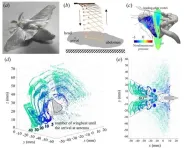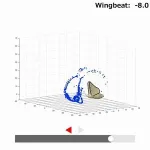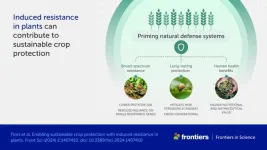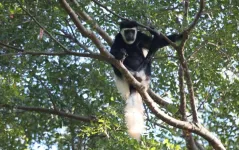Study uncovers how silkworm moth's odor detection may improve robotics
Research reveals how wing fanning aids pheromone detection in silkworm moths, offering new insights for odor source localization technologies in robotics
2024-10-15
(Press-News.org)
The silkworm moth (Bombyx mori) is an insect that no longer flies due to domestication. The males use their antennae to detect pheromones emitted by females and respond very acutely, and have been used as model insects for the study of their odor source localization. Flying insects flap their wings when they fly, and silkworm moths are also known to flap their wings (called fanning) when they detect pheromones, even though they do not fly. As pheromone molecules move through space in the air, the air flows produced by the flapping of wings have undoubtedly a strong influence on odor detection. However, the effect of this flapping of wings was not known quantitatively.
To address this question, a group of scientists led by Dr. Toshiyuki Nakata from the Graduate School of Engineering, Chiba University, investigated how B. mori detects pheromones. “We understand that silkworm moths detect pheromones by flapping their wings to induce airflows around them. However, the precise impact of this wing flapping on the moths' ability to localize the odor source is unclear,” explains Nakata, while elaborating on the rationale for conducting this study. The team included co-first author, Daigo Terutsuki from the Faculty of Textile Science and Technology, Shinshu University; Chihiro Fukui, from the Graduate School of Science & Engineering, Chiba University; Ryohei Kanzaki, from the Research Center for Advanced Science and Technology, The University of Tokyo; and Hao Liu, from the Graduate School of Engineering, Chiba University.
Their study, published on August 2, 2024, in Volume 14 of Scientific Reports, employed high-speed photogrammetry—a technique that uses high-speed cameras to capture and reconstruct the motion and geometry of objects—to computationally analyze the aerodynamic consequences of wing motions of B. mori. Researchers meticulously recorded the wing movements during fanning and built a detailed computational model of the insects and surrounding airflow. Using the simulated data, they subsequently calculated the motion of particles that resemble the pheromone molecules around the fanning silkworm moth.
One of the key findings of the study was that B. mori samples the pheromone selectively from the front. The moth scans the space by rotating its body while fanning to locate the pheromone sources. The directional sampling of the pheromone molecules is particularly helpful when searching for an odor source since the moth can determine the direction of the odor plume upon the detection of the pheromone.
Needless to say, the implications of this research extend beyond the study of insects. The insights gained from how B. mori manipulates airflow could lead to advancements in robotic odor source localization technologies. A team led by Dr. Daigo Terutsuki is working on developing drones equipped with insect antennae for odor detection, with potential applications such as locating individuals in emergencies. “The findings from this study highlight the importance of creating directional airflow when searching for odor sources using flying robots. This involves carefully adjusting the drone’s orientation and the configuration of its propellers and odor sensors to optimize detection capabilities,” notes Dr. Nakata.
Furthermore, the study highlights the need for future research to consider environmental factors such as airflow turbulence and antenna structure, which also influence odor detection. “Currently, robots rely heavily on vision and auditory sensors for navigation. However, as demonstrated by disaster rescue dogs, utilizing the sense of smell can be highly effective for locating humans. While the application of sensing smell in robots is still in its early stages, this research could help in developing robots that efficiently search for odor sources in disaster situations,” says Dr. Nakata optimistically.
In summary, this study not only advances our knowledge of insects’ odor-detecting strategies but also provides valuable design principles for the next generation of aerial odor-detecting robots.
About Associate Professor Toshiyuki Nakata
Dr. Toshiyuki Nakata is an Associate Professor with a research focus on understanding how flying animals navigate and utilize air to achieve various goals, including efficient long-distance flight and effective localization of food and mates. His work employs advanced engineering tools, including computational simulations and robotics, to investigate these phenomena and develop bio-inspired robots based on his findings. Dr. Nakata is actively involved in several academic societies, including the Japan Society of Mechanical Engineers and the Society of Aero Aqua Bio-mechanisms. His recent research interests include non-flapping flight in insects and birds and the mechanisms of olfactory and auditory navigation in insects.
END
ELSE PRESS RELEASES FROM THIS DATE:
2024-10-15
Obesity is a widespread public health challenge in the Middle East, maintaining prevalence in 54.2% of women and 31.4% of men in this region. Overweight and obese women have a higher risk of hypertension and cardiovascular risk factors than women with a standard BMI, according to an analysis of the ANCORS-YW STUDY presented at ACC Middle East 2024. The findings highlight the urgent need for targeted interventions that address socioeconomic determinants of health to reduce the cardiovascular risk ...
2024-10-15
In a growing and changing world, we need to find ways of putting food on everyone’s table. Pesticides have enabled mass cultivation on an incredible scale, but they can have harmful secondary effects on humans and wildlife, and pests are rapidly evolving to overcome them. To overcome this challenge and develop the sustainable and resilient agriculture of the future, scientists writing in Frontiers in Science explore the potential of induced resistance. Like a vaccination for plants, it deliberately triggers a plant’s immune system, so that when the plant encounters a similar ...
2024-10-15
Seven New Frog Species Discovered in Madagascar: Sounds Like Something from Star Trek
An international team of researchers have discovered seven new species of tree frogs that make otherworldly calls in the rainforests of Madagascar. Their strange, high-pitched whistling calls sound more like sound effects from the sci-fi series Star Trek. As a result, the researchers have named the new species after seven of the series' most iconic
If you think all frogs croak, you’d be wrong. Seven newly discovered species from the tree frog genus Boophis, found across the rainforests of Madagascar, emit special bird-like whistling ...
2024-10-15
Two thirds of Key Biodiversity Areas (KBAs) in tropical forests are experiencing new temperature conditions as our climate changes, research shows.
KBAs identify the most important places on Earth for species and their habitats.
The new study – by Exeter, Manchester Metropolitan and Cambridge universities – assessed 30 years of temperature conditions below the forest canopy in KBAs in tropical forests worldwide.
It found that 66% of KBAs in tropical forests have recently transitioned to new “temperature regimes” (more than 40% of temperature measurements being outside the range previously recorded ...
2024-10-15
NEW YORK, NY — How do we distinguish threat from safety? It’s a question important not just in our daily lives, but for human disorders linked with fear of others, such as social anxiety or post-traumatic stress disorder (PTSD). The microscope image accompanying this press release, from the laboratory of Steven A. Siegelbaum, PhD, at Columbia’s Zuckerman Institute, displays a powerful technique scientists used to help us find an answer.
The scientists were investigating the hippocampus, a brain area that plays a key role in memory in humans and mice. Specifically, they focused on the CA2 region, which is ...
2024-10-15
In a new study published in Nature Communications Biology, wildlife rangers from the Uganda Wildlife Authority have demonstrated their ability to generate precise and reliable data on lion populations in Uganda’s Nile Delta, a critical stronghold for African lions.
The study reveals that wildlife rangers, a critical component of global conservation efforts but often underutilised in scientific research, can play a pivotal role in the conservation science surrounding the world’s most beloved big cat.
Rangers are effective at monitoring lions and are an underutilised resource
The study showed rangers ...
2024-10-15
One of the most notorious mass extinction events in modern times occurred on a hilltop in coastal Ecuador in the 1980s. Ninety species of plants known from nowhere else on Earth—many of them new to science and not yet given a name—went extinct when the last cloud forests of the Centinela range were cleared for agriculture. The cautionary tale of Centinela has long been a driving force in the fight to save the world’s rainforests. But did it really happen?
In a new study published in Nature Plants, an international team of botanists reveals that, indeed, it did not happen. The researchers – who spent years of scouring natural history museums, biodiversity databases, ...
2024-10-15
About The Study: Among individuals with ulcerative colitis, the allele HLA-DRB1*01:03 was associated with severe ulcerative colitis requiring major operation, hospitalization, and systemic corticosteroid use compared with less severe disease. HLA-DRB1*01:03 has previously been linked to ulcerative colitis incidence. This study supports earlier, targeted genetic studies comparing patients with healthy controls reporting an association with total disease and severe disease requiring colectomy.
Corresponding Author: To contact the corresponding author, Marie Vibeke Vestergaard, MSc, email marievv@dcm.aau.dk.
To access the embargoed study: Visit our ...
2024-10-15
Montpellier, France – 15 October 2024. In a captivating Genomic Press Interview published on October 15, 2024, in the peer-reviewed journal Genomic Psychiatry (Genomic Press), Professor Philippe Courtet shares groundbreaking perspectives on suicide prevention and mental health care. As an influential PU-PH (Professeur des Universités-Praticien Hospitalier), he is a Professor of Psychiatry at the University of Montpellier, France, and head of emergency psychiatry at the University Hospital of, Professor Courtet stands at the forefront of ...
2024-10-15
Miscarriage, or early pregnancy loss, can have devastating emotional effects, but it is poorly managed in Canada. A review published in CMAJ (Canadian Medical Association Journal) https://www.cmaj.ca/lookup/doi/10.1503/cmaj.231489 provides guidance to physicians on how to diagnose and manage this condition and calls for referral to outpatient early pregnancy assessment clinics (EPACs) as well as a compassionate approach.
October 15 is Pregnancy and Infant Loss Remembrance Day.
Data suggest that 15%–20% of all confirmed pregnancies result in miscarriage, with ...
LAST 30 PRESS RELEASES:
[Press-News.org] Study uncovers how silkworm moth's odor detection may improve robotics
Research reveals how wing fanning aids pheromone detection in silkworm moths, offering new insights for odor source localization technologies in robotics









